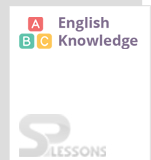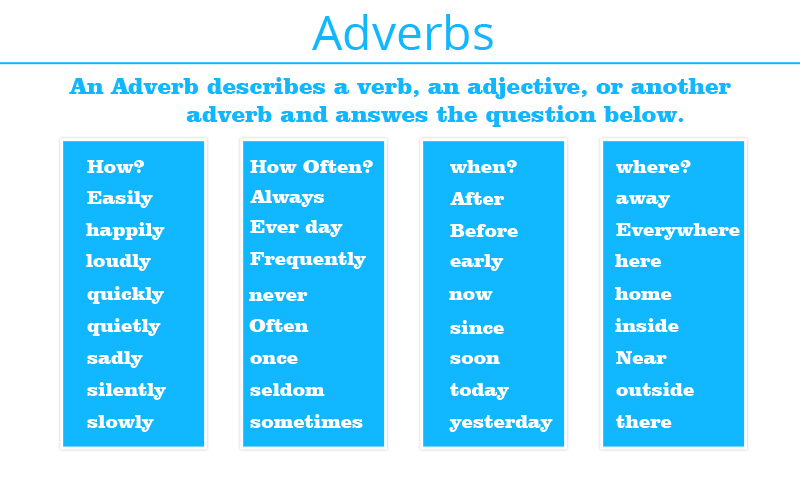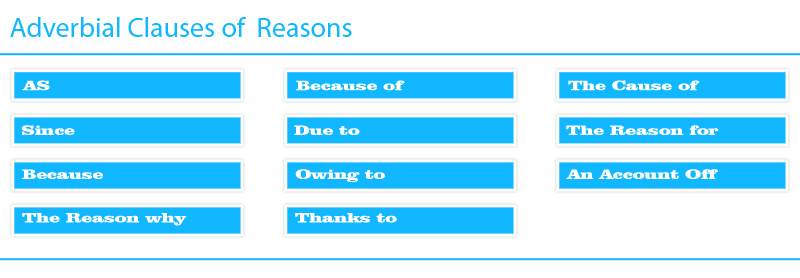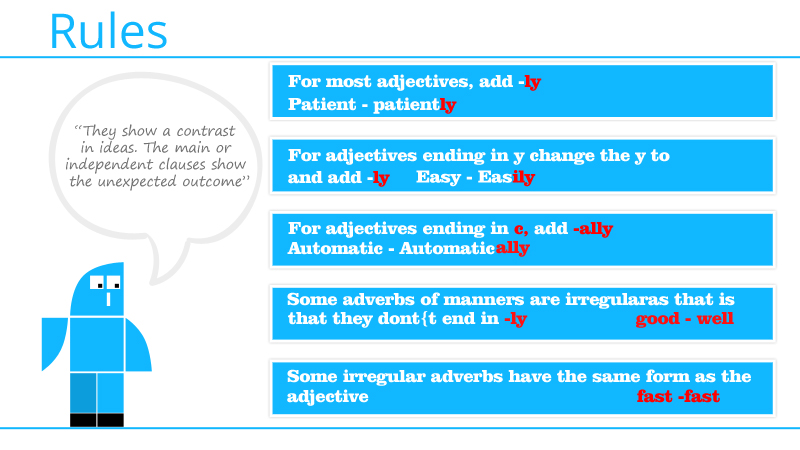 Introduction
Introduction
Words or phrases that modify, qualify or explain the various verbs, adjectives or another adverb are called Adverbs. In short, an adverb describes actions, and it describes other descriptive words.
Examples: quickly, sadly, loudly, extremely, outside, seldom, silently, slowly etc.
- She could easily divide the sweets among st themselves.
- There was blood everywhere in the room.
| Adverbs modifying Verbs | When an adverb changes verb a little, it generally tells us when where, how or in what manner is it changing the verb. | 1. Raghu placed the showpiece carefully on the table. In this sentence, an adverb is carefully showing how the showpiece was kept. | 2. Heena dances gracefully. In this sentence, an adverb is gracefully modifying the verb dance. | 3. She sometimes helps her classmates. In this sentence, sometimes is modifying to help. |
| Adverbs modifying Adjectives | Adverbs can also change adjectives. | 1. That was extremely rude of you. How rude? | 2. This is a very beautiful flower. How beautiful the flower is? | 3. The rabbit is bright white. How white is the rabbit? |
| Adverbs modifying other Adverbs | Sometimes adverbs can also modify other adverbs in the sentence. | 1. She speaks incredibly softly. How softly does she speak? | 2. Peter finished his assignment very quickly. How quickly did he finish the assignment? | 3. The wounded bird flew very slowly. How slow was the bird flying? |
 Types
Types
Types of Adverbs:
Adverbs can be divided into different categories as shown in the image and as described in the below column.
Types of Adverbs:
1. Adverb of Time:
An adverb which tells the reader when the situation happened or when a task is done is called adverb of time. When it is used at the beginning of the sentence, it is used as a form of emphasis.
For example: today, tomorrow, yesterday, then, now etc.
2. Adverb of Place:
The place where the action is being done is called adverb of place. For example: here, there, inside, outside, inside, bottom, somewhere, beneath etc.
3. Adverb of Manner
When an adverb tells us how the action is being done or happens, it is then called adverb of manner.
For example: happily, sadly, slowly, frequently, quickly etc.
Comparative and Superlative Adverbs:
Comparative Adverbs: Adverbs which are used to compare two different actions or states are called comparative adverbs.
For example: faster than, slower than, quicker than, higher than, brighter than etc.
The table below shows some more superlative and comparative adverbs to make you clearer.
Regular and Irregular Adverb:
Regular adverbs: Adverbs formed by taking an adjective and adding ‘ly’ suffix to it makes it a regular adverb.
For example:
| Manner | Frequency | Degree |
|---|---|---|
| Fortunately | Always | Almost |
| Unfortunately | Usually | Nearly |
| Luckily | Often | Quite |
| Unluckily | Sometimes | Completely |
| Immediately | Occasionally | Very |
| Surprisingly | Seldom/rarely | Extremely |
| Personally | Never | A bit |
| Honestly | A little | |
| Seriously | Highly | |
| Suddenly | Bitterly | |
| Interesting | Painfully | |
| Confidently | Enough | |
| Officially | Very | |
| Obviously | too |
- The buildings were set on fire yesterday.
- He does not read the newspaper daily.
| Always | Formerly | Occasionally |
| Annually | Fortnightly | Previously |
| Infrequently | Generally | Quarterly |
| Before | Late | Recently |
| Constantly | Later | Seldom |
| Earlier | Lately | Sometimes |
| Eventually | Now | Random |
| Ever | Normally | Since |
| Finally | Never | Soon |
| Frequently | Next | Still |
- Roses grow everywhere.
- Amsterdam is in America.
| About | Above | Abroad |
| Anywhere | Away | Back |
| Backward | Behind | Below |
| Down | Downstairs | East |
| Elsewhere | Fast | Here |
| In | Indoor | Inside |
| Near | Nearby | Off |
| On | Out | Outside |
| Over | There | Towards |
| Under | Up | Upstairs |
- He solved the riddles easily.
- He often goes to America to visit his relatives.
- The news was too good to be true.
- The lady had suffered enough violence at the hands of her husband.
- If it rains, the taxi fare will shoot up.
- The teacher refused to teach unless the students apologized.
- Even if she starts right away, she will not be able to reach on time.
- Tina is bold enough to go around while Reena is not that capable.
- Given today’s weather forecast, you should expect a storm.
- Because the father was present, nobody could misbehave.
- The best friends met daily.
- Most of the times he does not care about anyone
| Frequency | Adverb of Frequency | Example |
|---|---|---|
| 100% | Always | I always talk to my mother about my day at office. |
| 90% | Usually | I usually have a glass of milk before going to bed. |
| 80% | Normally/generally | I normally go to the temple before starting my day. |
| 70% | Often/frequently | I use my cell phone often. |
| 50% | Sometimes | Sometimes I agree with what my brother says. |
| 30% | Occasionally | He occasionally goes to meet his relatives. |
| 10% | Seldom | I seldom read any books. |
| 5% | Rarely/ hardly ever | He hardly drinks alcohol. |
| 0% | Never | I never smoke with my friends. |
- Could this road trip get any better?
- My rank in the video game was higher than my brother’s.
- This is the thickest book that I have ever read.
- There is always a wisest person in a group of friends.
| Type of Adverb | Exceptional Adverbs |
|---|---|
| Adverb of time | Yesterday, daily, then |
| Adverb of place | Here, up, down |
| Adverb of degree | Very, really, almost |
| Positive Adverb | Comparative Adverb | Superlative Adverb |
|---|---|---|
| Angry | Angrier than | The angriest |
| Big | Bigger than | The biggest |
| Cold | Colder than | The coldest |
| Dark | Darker than | The darkest |
| Early | Earlier than | The earliest |
| Fast | Faster than | The fastest |
| Great | Greater than | The greatest |
| High | Higher than | The highest |
| Longer | Longer than | The longest |
| Pretty | Prettier than | The prettiest |
| Sweet | Sweeter than | The sweetest |
| Thick | Thicker than | The thickest |
| Wide | Wider than | The widest |
- Quick- Quickly
- Happy- Happily
| Adverb | Comparative | Superlative |
|---|---|---|
| Badly | Worse | Worst |
| Much | More | Must |
| Little | Less | Least |
| Well | Better | Best |
 Rules & Tips
Rules & Tips
Rules and Tips for Using Adverbs:
There are few rules to be kept in mind for the easy and smooth use of adverbs in English language. These are as follows.
Rule 1: Adverb of time, like seldom, generally usually, hardly, rarely etc comes before the verb which the adverb has to modify.
For example:
- She sometimes feels nervous while giving the presentation.
- He often does very neat homework.
- The choir sang the song beautifully.
- The team played the last match confidently.
- He worked hard to complete the project.
- The children took the matter very seriously.
- It is nothing else but laziness that does not let you work.
- That was nothing but an animal that you saw.
- He has no other choice than leaving the room.
- Yes I have completed the project.
- No I did not go to the party.
- She regards us as her family.
- The process was described as a complex process.
- The teacher calls her students intelligent.
- One student was elected the class representative.
- He rarely comes to visit his old parents.
- The family hardly knew anybody here.
- Kerala is a very beautiful place.
- My sister is very happy after getting the job.
- My brother is much taller than me.
- My friend completed the mission of the game much faster.
- He is so powerful that nobody messes with him.
- She is too good at writing.
- They have enough time to play.
- He is good enough to be selected into the team.
- Unfortunately the doctor will not come for one week.
- Surprisingly the team that was assumed to be the weakest won the series.
- The boy ran incredibly quickly.
- His talks are exceptionally wisely.
 Errors
Errors
Adverbs are used in different ways in different sentences. It is difficult to use adverbs because some people use adjectives in place of adverbs.
Some common errors while using the adverbs are as follows:
- He couldn’t help not overhearing the teachers’ conversation. He couldn’t help overhearing the teachers’ conversation. (No two negatives come together in the same sentence.)
- I ever remember having read a more interesting novel. I never remember having read a more interesting novel. (Wrong use of ever and never)
- It was bitter cool. It was bitterly cool. (Wrong use of adjectives in place of adverbs)
- She was much happy to see her family. She was very happy to see her family. (See is an adjective. Much is not used with an adjective.)
- She plays basketball good. She plays basketball well. (Well is an adverb, good is an adjective.)
- We are very much sorry. We are very sorry. (Before adjectives, very is used without much and adverbs are used in a positive degree.)
- She is much tired after the journey. She is very tired after the journey. (In this sentence, much and very do not mean the same.)
- He very carefully drove. He drove very carefully. (Adverbs of manner generally come at the end of the sentence.)
- The house is enough spacious for us. The house is spacious enough for us. (The adverb ‘enough’ is placed after adjective or the adverb it is modifying.)
- I know to ride a bicycle. I know how to ride a bicycle. (An infinitive cannot b directly followed by know. Instead always remember to use knows how to.)








